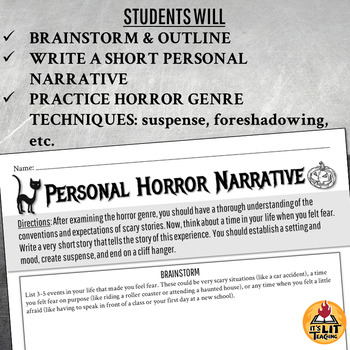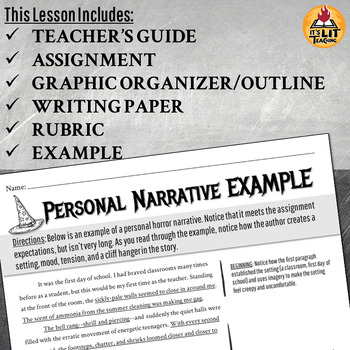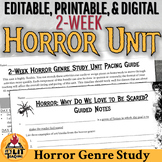Personal Horror Narrative Writing Activity | Printable & Digital
- Google Drive™ folder

What educators are saying
Also included in
- This incredibly flexible horror genre study unit will turn students into masters of foreshadowing, suspense, mood, and more with fun, engaging, and creepy tales! Students will learn about the horror genre, then read three scary stories, before exploring writing a horror narrative themselves.This uniPrice $13.55Original Price $16.99Save $3.44
Description
Assess students on their understanding of suspense, mood, and the horror genre with this personal narrative writing activity. Students will write a short story about a scary memory while trying to incorporate crucial elements of the horror genre. This writing activity is a great assessment, enrichment opportunity, or just a fun activity to do around Halloween!
Students will first brainstorm times in their lives when they felt fear. Then, they'll map out ideas for creating a creepy setting and pacing the story to build suspense. Even though the final story can be very short, trying to build suspense and establish mood will challenge all students to think creatively, regardless of their writing ability!
This resource is highly flexible and includes various versions of each component, so you can teach this activity in-person or remotely through an online classroom.
This product includes:
- Teacher Guide
- Personal Horror Narrative Assignment and Brainstorming Sheet
- Printable PDF
- Fillable PDF
- EDITABLE Google Doc
- Personal Horror Narrative Outline Worksheet
- Printable PDF
- Fillable PDF
- EDITABLE Google Doc
- Personal Horror Narrative Writing Paper
- Printable PDF
- Fillable PDF
- EDITABLE Google Doc
- Personal Horror Narrative Example
- PDF with annotations
- PDF without annotations
- Personal Horror Narrative Writing Activity Rubric
- EDITABLE Google Doc
- EDITABLE Google Sheet (for easy upload into Google Classroom)
Be sure to check the preview to see printable versions of the above! Please note that not every included document is editable (editable files are marked as such above)!
This resource can be a wonderful activity on its own. It was, however, created to be a final assessment or project for my other Horror Genre Study resources.
Other Resources You May Enjoy:
- Horror Genre Study Introductory Lesson: This is a great lesson to introduce the horror genre
- Suspense Analysis with Horror Shorts Activity: Use this activity before writing this personal horror narrative to help students practice analyzing suspense
- "Popsy" by Stephen King Story Study: A fantastic example of horror; read, analyze, and write on King's creepy tale
- "Out of Skin" by E. M. Carroll Story Study: A horror web-comic! This is fun, engaging, and great for analyzing mood!
- "The Landlady" by Roald Dahl: A great horror short story, this lesson is perfect for reinforcing foreshadowing and suspense with students.
- 2-Sentence Horror Stories FREEBIE: Students will write a creepy tale using only two sentences
***This resource is contained within a Google file. Included are NON-EDITABLE PDF files. Before purchasing, please review the preview to make sure this resource supports your and your students' needs. The whole resource, with the exception of any answer keys, are included in the preview.






